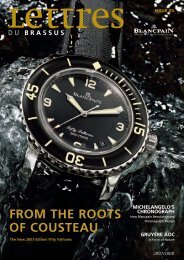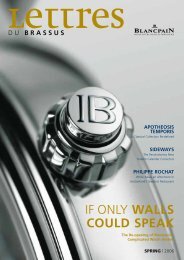THE HISTORY OF BLANCPAIN
THE HISTORY OF BLANCPAIN
THE HISTORY OF BLANCPAIN
Create successful ePaper yourself
Turn your PDF publications into a flip-book with our unique Google optimized e-Paper software.
At midnight this comfortable relationship<br />
changes briefly. Riding along the edge of the<br />
cam, C, is an arm, E, with a ruby at its tip.<br />
This arm is held against the turning cam by<br />
a spring. Looking carefully at the cam, one<br />
can see a large bump or nose, followed by a<br />
trough. The “nose” is at the midnight position.<br />
Once the cam rotates to this position,<br />
the force of the spring loaded ruby tipped<br />
arm suddenly jumps the cam forward as the<br />
spring forces the ruby into the trough just<br />
aft of the nose. This, of course, produces an<br />
instant clockwise jump in the position of the<br />
cam and of the gear, D, attached to it. This<br />
sudden jump at midnight, powered by the<br />
spring is a key element in achieving an<br />
instant change in the date and represents<br />
the key output of this system.<br />
It is worth mentioning that the cam, C,<br />
and gear, D, are able to free themselves from<br />
the otherwise constant rotation of the wheel,<br />
B, because their “connection” to the wheel,<br />
B, is via the pin riding in the slot. When the<br />
cam jumps forward, the pin merely shifts to<br />
the far end of its slot. As the wheel, B, continues<br />
to rotate, it will shortly catch up to the<br />
pin and resume dragging it around again for<br />
the remainder of the 24 hour period.<br />
E<br />
B<br />
C<br />
A<br />
D<br />
Fig. 2<br />
The system of the 24 hour wheel and instant date change cam.<br />
The date change for single digits and the<br />
actuating/blocking spring (Figs. 3 and 4).<br />
The key output of the previous set of elements<br />
was a sudden jump at midnight of the<br />
wheel, D. That wheel is engaged with wheel,<br />
F, which turns counterclockwise. Both the<br />
wheel, D, and the wheel, F, turn once every<br />
24 hours, of course.<br />
So what is the effect of the sudden jump<br />
forward at midnight caused by the spring<br />
loaded arm falling from the nose into the<br />
trough on the cam? It produces a sudden<br />
jump counterclockwise in the rotation of the<br />
wheel, F, and the actuating/blocking spring,<br />
G, which is attached to it. The resulting<br />
counterclockwise jump in the actuating/<br />
blocking spring causes it to grab one tooth<br />
of the 31 tooth wheel, H, to its right, turning<br />
that wheel clockwise. Through yet another<br />
gear described below, this turns the single<br />
digit wheel one position, causing an instant<br />
one day advance in the date display. Of<br />
course the wheel, H, has 31 teeth, one for<br />
each day.<br />
The actuating/blocking spring has one<br />
other function, which is suggested by the<br />
second word in its description. After it<br />
66<br />
| 67<br />
moves the 31 tooth gear, H, one tooth,<br />
it acts to block any further movement in<br />
the gear. This provides insurance against a<br />
shock-induced unwanted change in date.<br />
Apart from its blocking function, why is<br />
the engagement with the 31 tooth gear, H,<br />
done via a spring, as opposed to a rigid finger?<br />
The answer is protection against date<br />
changes backwards through midnight. If the<br />
crown were wound backwards and the date<br />
change effectuated by a rigid finger, there<br />
would be a substantial risk that the mechanism<br />
would be broken as the time passed<br />
backwards through midnight. But because<br />
the connection is done via a spring, a backwards<br />
time change allows the gears to turn<br />
past the spring, sparing the mechanism from<br />
harm.<br />
The second major element of the single<br />
digit change is yet another 31 tooth gear, I,<br />
which turns counterclockwise. This gear can<br />
be thought of as a form of programme<br />
wheel. For most of its rotation throughout<br />
the days of the month – it moves one tooth<br />
per day – it causes the 10 tooth gear, J, to<br />
its right to turn clockwise one tooth per day.<br />
The single digit date disc is attached to the<br />
10 tooth gear and it therefore advances one<br />
Fig. 3<br />
The date change for single digits and the actuating/blocking spring.<br />
G<br />
H<br />
I<br />
F







